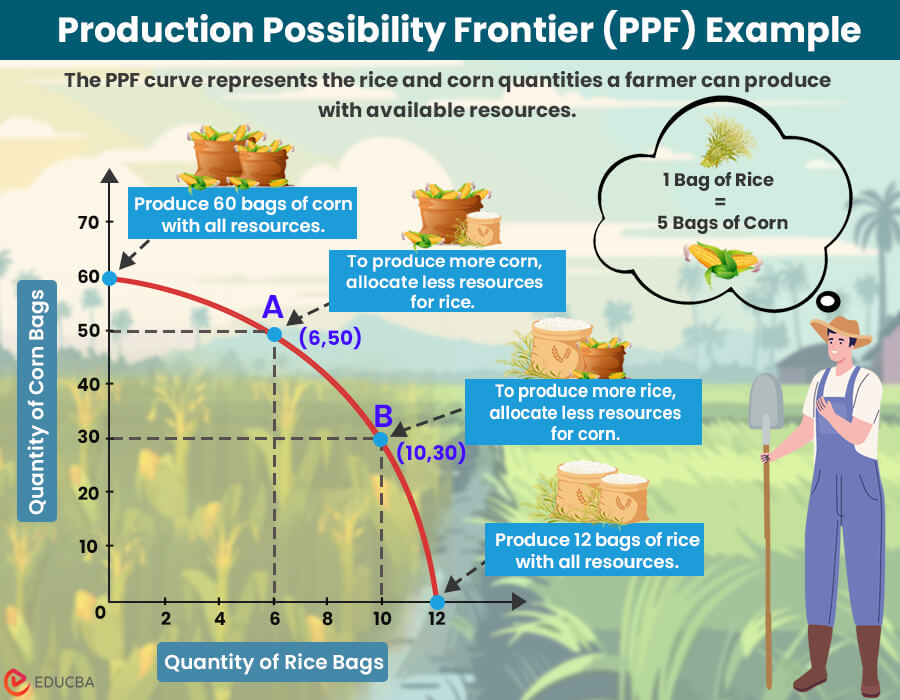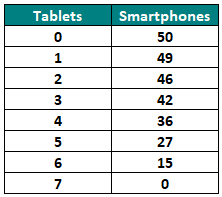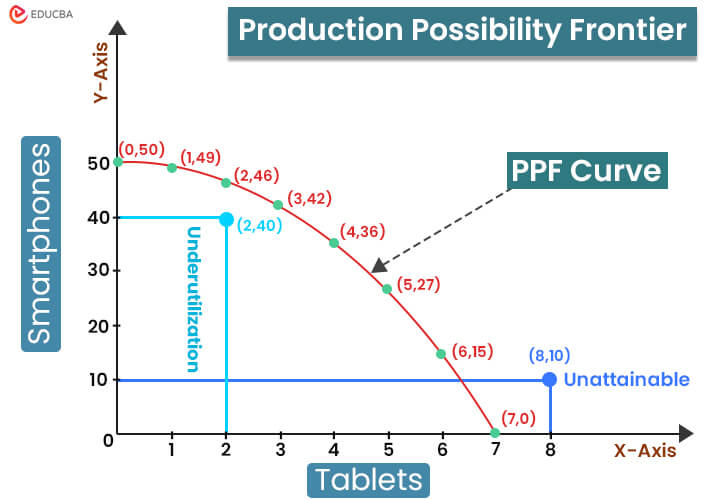
What is the Production Possibility Frontier?
A production possibility frontier (PPF) is a curve on a graph that shows different points. These points represent how a business can produce two different products using available resources to attain maximum productivity.
A production possibility frontier in economics actually shows the trade-offs between the two products. This shows how a company can use its limited resources to produce two products, for example, tablets and smartphones. Each point on the curve represents the most efficient way of using resources to produce tablets and smartphones. Making quantity above and below these points could produce more of one quantity, either tablets or smartphones.
So, if an economy uses its resources to produce more quantity of one kind of good, it must produce fewer quantities of another good.
Moreover, the PPF assumes that resources (labor, capital, and technology) are limited or scarce. Considering these limited or scarce resources, a company can decide:
- What to produce?
- How much to produce?
Table of Contents
- What is it?
- Understanding PPF (with simple example)
- PPF Graph (with advanced example)
- Model
- What Shifts the PPF?
- Importance in Economics
Understanding Production Possibility Frontier (With Simple Example)
Let’s consider a scenario of a farmer, David, who produces rice and corn. The production possibility frontier curve will assist David in determining the maximum quantity of rice and corn he can produce with the available resources, such as land, labor, and capital. Here, the curve represents the quantity of rice on the X-axis and the quantity of corn on the Y-axis. Therefore, each point represents the combination of rice quantity and the corresponding corn quantity he can produce with available resources.
We can make the following observations from the graph:
- If David uses all its resources to produce only corn, he can produce 60 bags of corn. The point would be at the extreme left of the curve.
- If he uses all its resources to produce only rice, he can produce 12 bags of rice and no corn. The point would be at the extreme right of the curve.
- If he uses its resources to produce 50 bags of corn, he can produce 6 bags of rice.
- Also, if he wants to produce more rice, he would have to allocate fewer resources to produce corn, so with 10 bags of rice, he can only produce 30 bags of corn.
From the graph, we can see that for 1 bushel of rice, he can produce 5 bags of corn from his available resources. Therefore, the points on the graph can help him determine the combination of rice and corn quantity he can produce to maximize its production.
Production Possibility Frontier Graph (With Advanced Example)
The following is an example of production possibility frontier to understand the graph.
Imagine a company that makes tablets and smartphones. With limited resources or materials, they produced the below number of tablets and smartphones using that limited material.
Solution:
Now, we can use this data and make a PPF curve to show the different combinations of products the company produced using limited materials.
Let’s plot these points on the Production Possibility Frontier PPF graph.
Where,
- X-axis: Represents the number of tablets.
- Y-axis: Represents the number of smartphones.
A) Meaning of different points on the above PPF graph:
- Point (0, 50): When the company allocated all its resources to producing smartphones, it produced 50, which means no resources were available for tablet production.
- Point (1, 49): As the company started to produce tablets, it allocated few resources to make them. So, to make 1 tablet, the company produced 49 smartphones. This moved the curve to the right on the graph, indicating a slight decrease in smartphone production.
- Point (2, 46): Now, they produced one more tablet, which caused a further shift of the curve on the right side. At this point, the production of smartphones decreased to 46.
- Point (3, 42): Further, the company allocated more resources to producing 3 tablets. This reduced the number of smartphones produced to 42 and caused a downward shift in the curve.
- Point (4, 36): As the company increased tablet production to 4, smartphone production decreased to 36. This indicates the company is allocating more resources to tablet production. Here, the curve moves further to the right side and downward.
- Point (5, 27): At this point, the company produced 5 tablets and 27 smartphones. The trade-off between tablets and smartphones continues, further decreasing smartphone production.
- Point (6, 15): Here, the company produced more tablets, i.e., 6, and smartphone production decreased to 15. The company used the majority of its limited resources in tablet production. The trade-off persists, moving the curve downward.
- Point (7, 0): At this extreme point, the company utilized all resources and focused entirely on tablet production (7) and produced no smartphones (0). The point on the curve finally reached the extreme right side.
Considering its limited resources, the above points show the different quantities of tablets and smartphones the company can produce.
B) Interpretation of the PPF graph
| Aspect | Points on the Graph | Interpretation |
| Efficient Points | Points on the graph, like (0, 50), (2, 46), (7, 0). | These points represent that the company fully utilizes its resources to produce an optimal number of tablets and smartphones. |
| Trade-offs | Tablet ↑, Smartphone ↓ (7, 0). Tablet ↓, Smartphone ↑ (1, 49). |
The graph shows the trade-off between tablets and smartphones. It means the more tablets the country makes, the fewer smartphones it can produce, and vice versa. |
| Underutilization | Suppose the company produced 2 tablets and 40 smartphones (2,40). | This point deviates from the efficient points, which shows underutilization. Meaning that the company is not using all its resources efficiently. It could make tablets and smartphones at a 2:46 or 3:42 ratio to attain maximum profit. |
| Unattainable | Suppose the company produced 8 tablets and 10 smartphones (8,10). | This point moves outside the main curve and shows an unattainable feature. It shows that current available resources may not be sufficient to produce this desired quantity (8,10). Achieving this point would require more resources or better technology. |
Model of the Production Possibility Frontier
The production possibility frontier model shows the following points or concepts.
1. Efficiency
Points on the PPF curve represent efficient utilization of resources, meaning that all available resources are fully employed to produce goods and services.
2. Inefficiency
Points inside the curve indicate the underutilization of resources. It means the economy is not fully utilizing the available resources.
3. Unattainability
While points outside the curve are unattainable, it means the economy cannot reach these points with the currently available resources and technology.
What Shifts the PPF?
The following factors cause a shift in the production possibility frontier (PPF) curve.
1. Technological Advancements
Where there is technological advancement, a company’s production capacity increases, causing the PPF to shift outward (right-side). Thus, a company can produce more products with the same amount of resources using better technology.
2. Changes in Resource Quantity or Quality
If there is an increase in the quantity or quality of resources, such as the new oil reserves, having a more skilled workforce or a higher capital can also shift the PPF outward. All these factors contribute to increased production output.
3. Changes in Institutional Factors
Government policies like regulations and taxes can also impact production efficiency. Positive changes, like lower regulatory burdens, may lead to an outward shift in the PPF. On the contrary, negative changes like higher taxes can lead to an inward shift in PPF.
4. External Factors
Natural disasters, wars, or global economic crises can negatively impact a country’s production capacity. These events can result in an inward shift of the PPF, indicating a decrease in the ability to produce goods.
Why is PPF Important in an Economy?
The importance of production possibility frontier in economics is as follows.
1. Helps in the efficient allocation of resources
PPF helps understand the trade-offs, enabling decision-makers to allocate resources efficiently to produce two different goods. They can also use different economic systems, such as market economies and supply and demand, to determine production quantities.
2. Helps in production decision-making
Decision-makers use PPF to make informed choices about the combination of goods to produce, considering opportunity costs and resource constraints.
3. Increases economic growth
Technological advancements, increased resources, or improved efficiency cause a shift in the PPF. This shift indicates a country’s economic health and growth.
4. Boosts productivity and unemployment
Some economies use PPF to enhance productivity and reduce unemployment. This helps bring more individuals into the workforce, increases wages, and increases the demand for goods.
Final Thoughts
This production possibility frontier shows the maximum output a company can achieve with its limited resources and technology. The points on the curve are not fixed, and many factors can influence the curve to shift either inwards (left side) or outwards (right side). Therefore, for a better economic future, a company must implement this model principle as a sustainable practice for resource allocation.
Recommended Articles
We hope this article on the “Production Possibility Frontier” was helpful. For more such economics-related articles, refer to the articles below.




